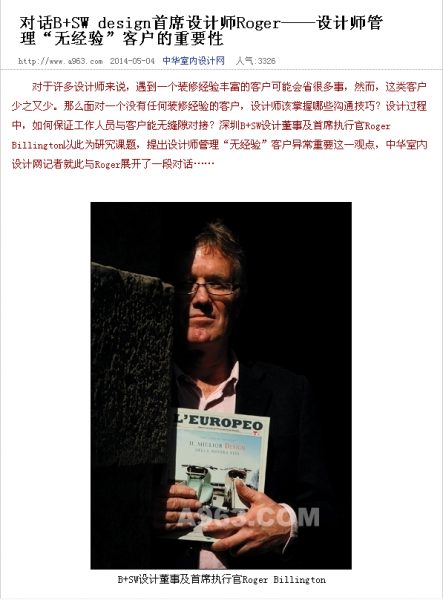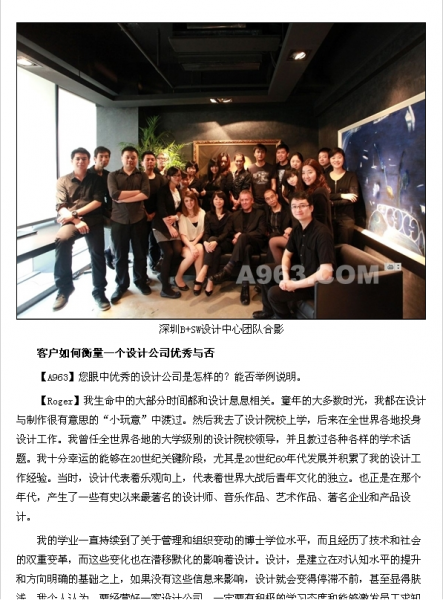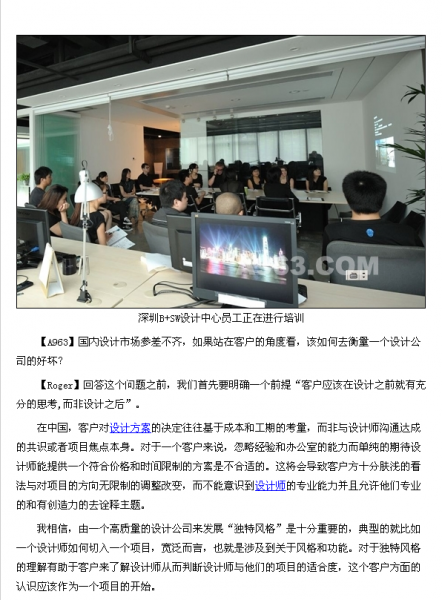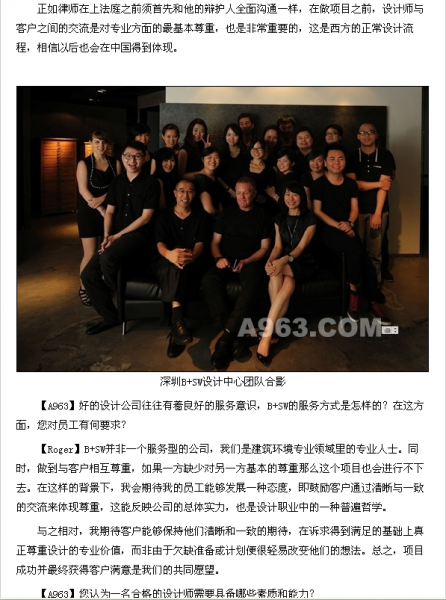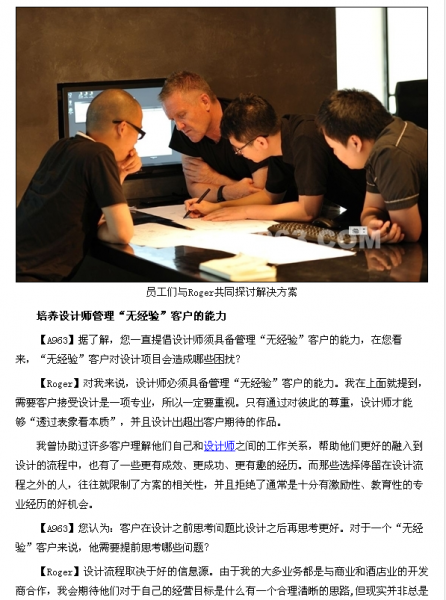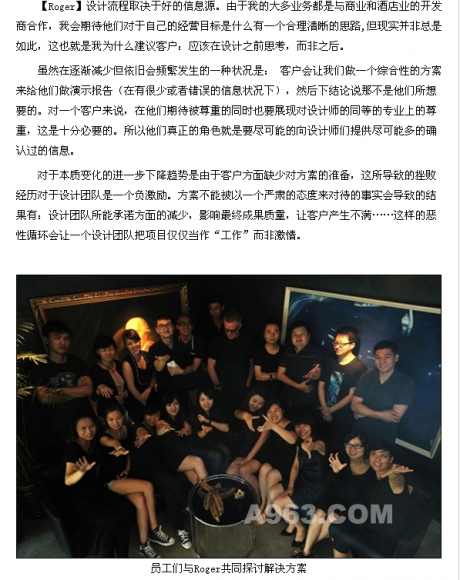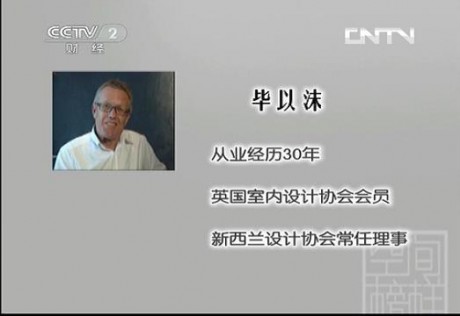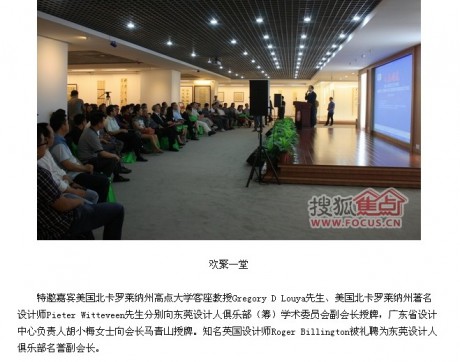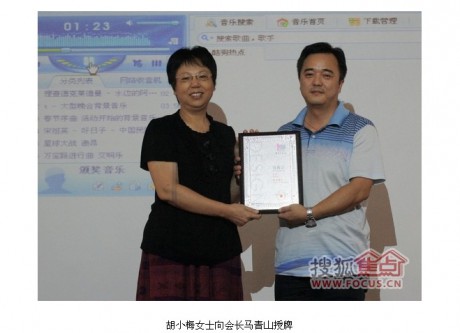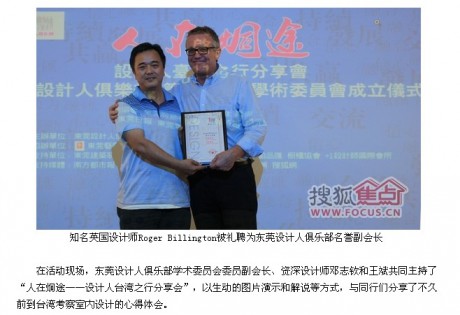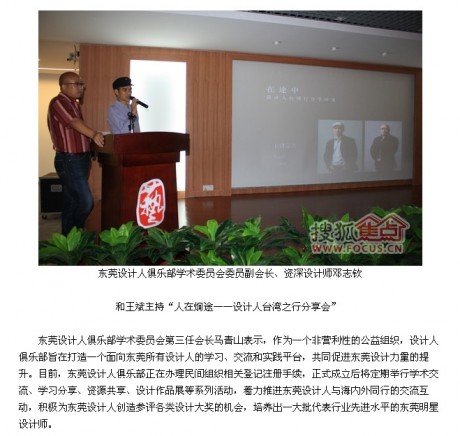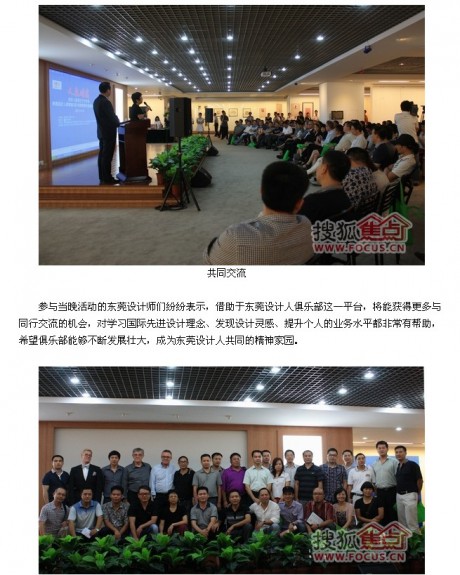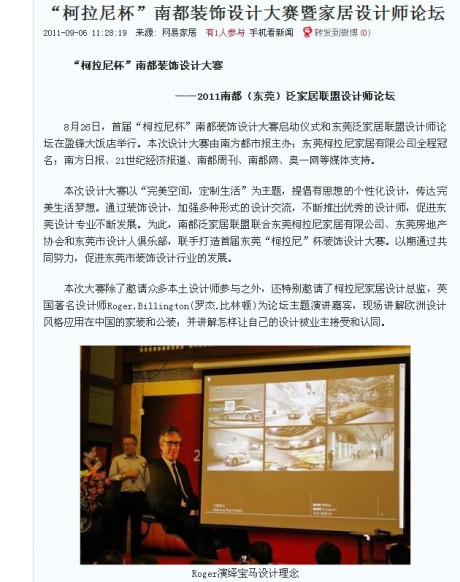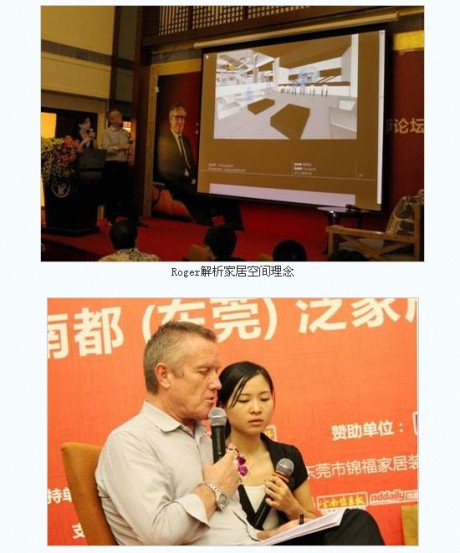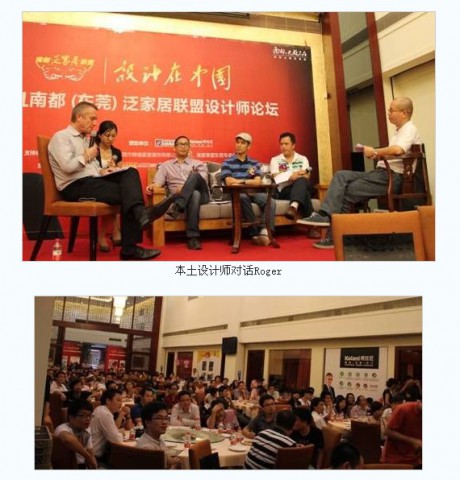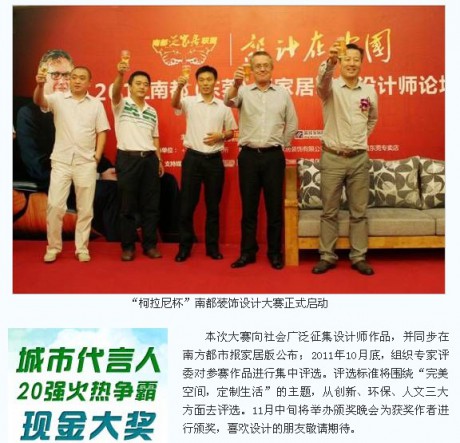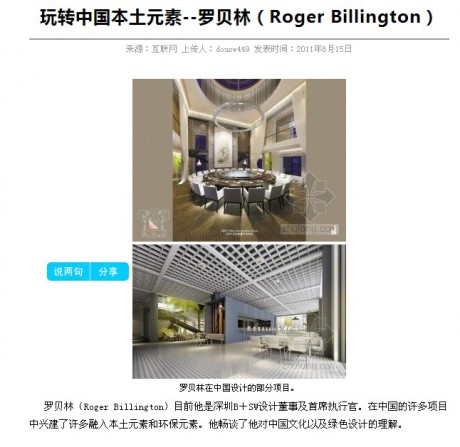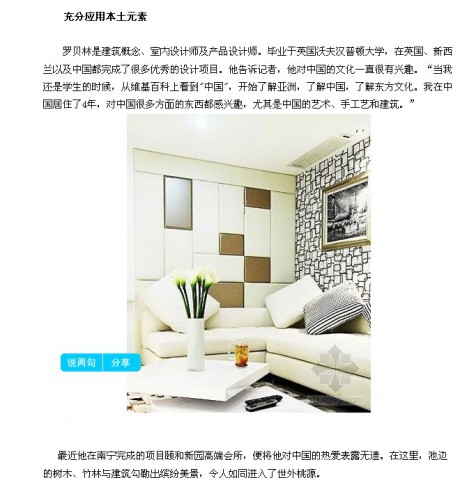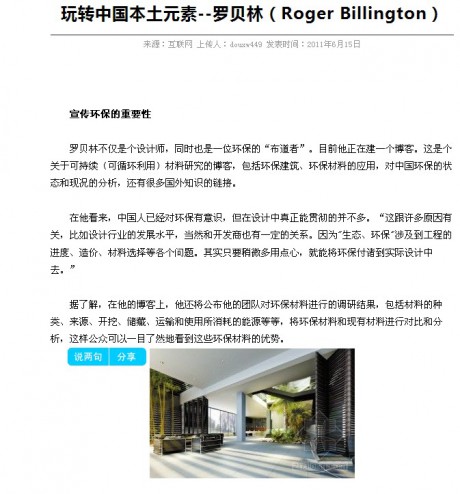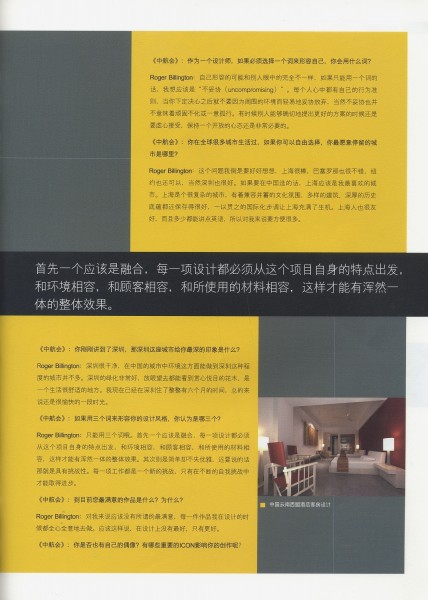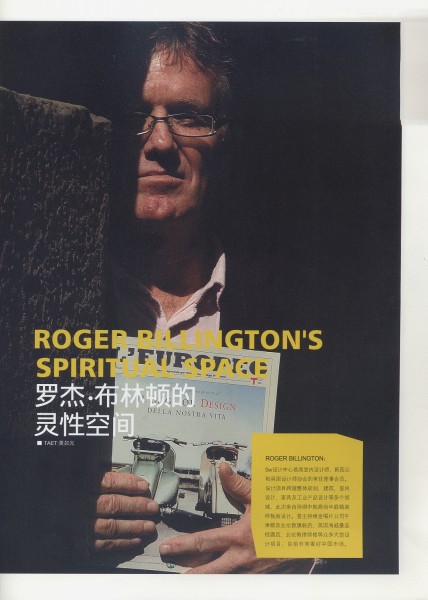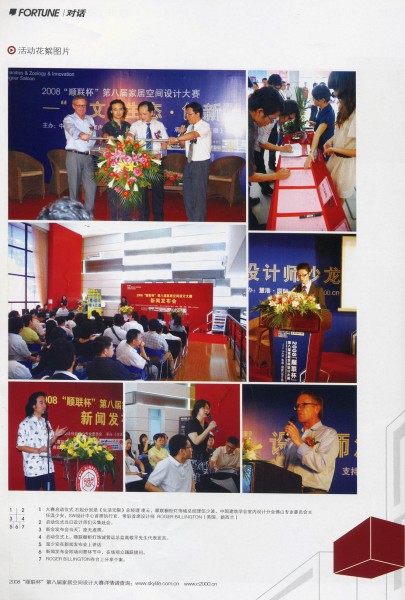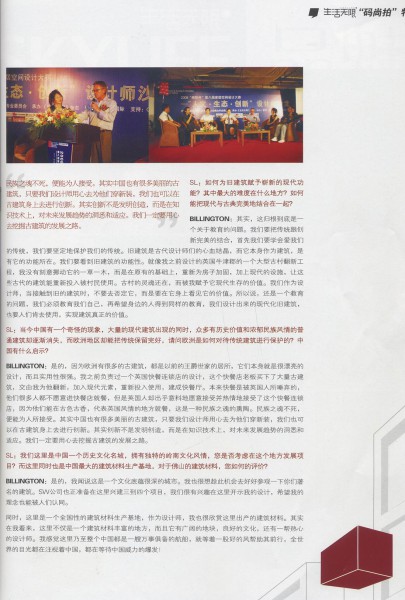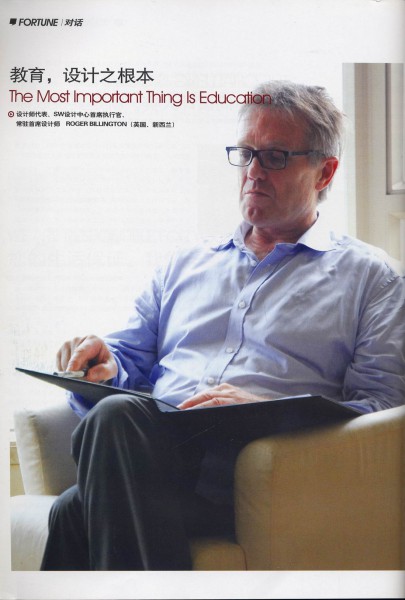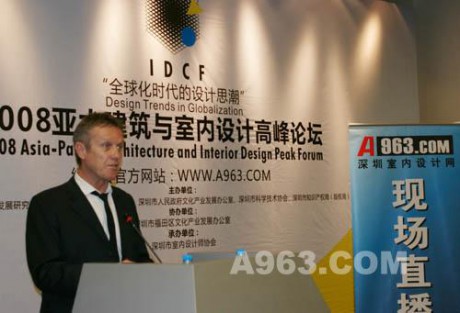

本月稍早时,Roger接受中华室内设计网A963.com采访。现将访谈内容辑录如下。
Roger interviewed by A963.com, the Chinese Interior Design Net, earlier this month
Theme: Located in a city of design, how does B+SW adapt to and lead the development of design? What’s your opinion about international design environment at home and abroad?
主题:B+SW设计中心设在“设计之都”,你们如何适应并引领设计的发展?你对于中国和海外的国际设计环境有何看法?
Roger: My business has always been based on a research approach to projects and, by consequence, developing a future focused capability in the designers who work here. We design from our knowledge and experience base, and if those bases are limited, then so is our ability to design with the credibility needed to convince clients that we are worth our fee, the better you are, the more you can charge. As in any other business, investment is needed to improve and our investments are in knowledge and technology. My design teams are all researchers and have a topic of their own choice, but must also be of value to the business. We also run a design history seminar every week, topics that extend designers understanding and appreciation of many diverse aspects of design, culture and society……check www.bswdesign.com.cn to see some examples, (although we are a little behind in these two areas at the moment).
我们公司一直采取研究式的方法做项目,使在这里工作的设计师培养出一种“着眼于未来”的能力。我们以我们的知识和经验作为设计的基础;我们需要拿出可靠的设计让客户确信我们“物有所值”,如果这个基础是有限的,则我们的能力也会受限,你的能力越强,就可以收取越高的费用。和其他一切行业一样,改良提高是需要投资的,而我们的投资就是知识和技术。在我的设计团队里,人人都是研究员,每人都有一个他们自己选择的专题,但是每个专题都必须具有商业价值。我们还每周举办一次设计史研讨会,研习的主题有助扩展设计师对于设计、文化、社会等许多不同方面的理解与认识。大家可以在我们的网站(www.bswdesign.com.cn)上看到一些例子(不过这两个板块的更新目前稍有滞后)。
A963: Hi, Roger. It has been seven years since Shenzhen was selected as the city of design, as a representative international company in Shenzhen, from which aspects does B+SW feel the encouragement and support for the design industry in Shenzhen?
嗨,Roger,深圳被选定为“设计之都”已经有七年了,B+SW作为深圳具有代表性的国际公司,从哪些方面感到了深圳设计产业所得到的鼓励和支持呢?
Roger: Support from who…?
Other than A963, I don’t see any support for design as a business in SZ. I think most businesses still see design as an expense, not an investment, that’s the basic problem here and that will only change when companies adopt an understanding that design assists the development of all aspects of biz from products, interiors, brand, print, web and marketing when they utilize a thinking design approach to their business, then design will flourish as it has in other countries. So if we can organize support for design and designers to help business to realize the values of design then that would be a good start, how to do this, I have some good ideas… read below…?
得到谁的支持呢?除了A963之外,我并没有在深圳看到对于设计作为一个产业的任何支持。我想大多数企业仍将设计视为一项开支,而不是投资,这就是根本问题。当企业明白到将思维设计的方法应用到业务中去时,设计可以从产品、室内空间、品牌、印刷品、网页和市场营销等方面促进业务全面发展,只有在这个时候,情况才会发生改变,而设计也才会像在其他国家一样繁荣。所以,如果我们能够为设计和设计师提供支持,帮助企业认识到设计的价值,那会是个很好的起点,至于如何来做,我有些不错的想法,下面会谈到。
A: China is developing rapidly. The Chinese government has just introduced upgrades in ten key sectors of manufacturing industry before, presenting the concept of ‘MADE IN CHINA 2025′. In your opinion, what can design bring to development? Pease give examples to illustrate it.
中国正在迅速发展。中国政府刚刚提出了“中国制造2025”的概念,宣布了制造业10大关键领域的升级计划。在你看来,设计能为发展带来什么?请举例说明。
R: I am currently promoting design led product development (DLPD) as a support to these government initiatives. All the ten areas for investment lack the benefit of an experienced commercialisation unit and that can be introduced through DLPD. DLPD is aprocess which can be applied to all products and services and through a series of evaluation stages ensures that products are ready for the market. In a globally competitive environment, if products are simply a good idea, or innovative technology, without satisfying more subtle consumer needs, then they will not be competitive with leading international products and services who’s design direction also focuses on ‘soft’ elements of development and social understanding of consumer wants and needs. The days of ‘making do’ have gone and manufacturers now have to understand the expectations of international consumers, and increasingly Chinese, who are showing preference to products that are environmentally safe, have sophisticated user considerations and are, of course well designed.
我目前正在推动以设计导向的产品开发(DLPD),作为对政府这些举措的支持。这十个投资方向现在都缺少一个有经验的商业化部门,这可以借由DLPD引进。DLPD是一个能够应用于所有产品和服务的流程,透过一系列评估阶段来确保产品具备投放市场的条件。在全球化竞争的环境下,如果产品只有好的构思或创新的技术,却不能满足消费者更精细的需求,那么在国际领先产品和服务面前就不具备竞争力。纵观国际领先的产品和服务,其设计方向也都专注于“软”发展元素和对消费者所想所需的社会共识。“将就凑合”的日子已经过去,制造商现在必须去理解国际消费者和越来越多中国消费者的期望,他们喜爱环保安全、对用户考虑细致周到的产品,当然还要设计优良。
A: What’s the reason that you pay attention to the policy of design investment? Is the fact that B+SW is an international design company counted in?
你关注设计投资政策的原因是什么?B+SW国际设计公司的背景会是其中一个因素吗?
R: Design investment…? Where….?
设计投资?哪儿?
A: Referring to investments in design field in foreign countries, taking Samsung as an example, its success is contributed to design, but government’s support also plays a very important role in its success. What’s your opinion about this phenomenon?
提到外国在设计领域的投资,以三星公司为例,它的成功固然要归功于设计,但是政府的支持也起到了非常重要的作用。你对这种现象有什么看法?
R: I don’t agree that the governments support has very much to do with the success of design led companies overseas. The majority of companies that describe themselves as design led are simply confident, innovative and technologically advanced and understand consumer expectations. The world has changed through generational evolution, many of the current older thoughts are still rooted in the post WWII thinking of, utility rather than excellence. This is understandable, the need for economy was necessary, but now with later generations, an expectation of top performance, user centered and value added are the norm. Price is an issue, technology is another, but design is the main differentiation between products these days, manufacturers who fail to understand this will not be with us for long. The brand development of a company relies on consumer appreciation of the design approach the companies take, so the importance of design cannot continue to be relegated to ‘making things look nice’… DLPD develops the holistic approach to a company’s organizational developments and products through design thinking techniques.
我并不认为政府支持对于外国设计导向型公司的成功起到了多大的作用。大多数以设计导向自称的公司只是自信、创新、技术先进并且明白消费者的期望。经过历代演变,这个世界已经改变,但目前许多较老的想法却仍旧植根于二战后的思维方式,讲求实用,而不是追求精良。这是可以理解的,对经济性的需求曾经是必需的,但是对于现在较年经的几代人而言,对顶尖的性能表现、以用户为中心和价值增加的期望才是准则。价格是问题,技术是另一个问题,但是设计才是当今不同产品之间最主要的差异所在,不能理解这一点的制造商不会生存太久。一个公司的品牌发展依赖于消费者对该公司所采取的设计态度的认同,所以设计的重要性不能继续屈就于“使东西看起来漂亮”。DLPD借助各种设计思维技巧形成一个企业组织发展和产品开发的整体方法。
A: Our designers have always kept a close contact with designers in Italy. As a leader of global design, why can they keep the edge in your opinion? What can we learn from them?
我们的设计师一直与意大利的设计师保持着紧密接触。作为全球设计的领导者,你认为他们是如何保持这种优势的?我们可以向他们学习什么?
R: I would say the most important thing to be learnt from Italian design is for business in China to appreciate the value and contribution design and designers can make to organizations, especially during a period of immense change, as China is in right now. Design is not simply how things look, it is about how to develop the whole manufacturing programme, the organization required to implement the programme and then how to market it, to whom and why. In the face of massive change themselves at the end of WWII, Italy developed this perception of excellence as designers, now because they ‘walk the talk’, their economy, post war, has been based on this belief and so they have made it a reality, (perception becomes reality) I do not think that Italian design is that good, but they do, and so it works, this confidence is what Chinese business can learn from the Italian model.
我会说要向意大利设计学习的最重要的东西,是中国的商业要学会欣赏设计和设计师所能为企业创造的价值与贡献,尤其是在巨变的时代,如眼下的中国。设计不仅仅是东西看起来如何,它还是关于如何建立整个制造方案、实施这个方案所需要的组织结构,然后到如何销售它、销售给什么人以及为什么。在二战结束面对巨变之时,意大利形成了这种设计师对卓越的感知,因为他们知行合一,战后经济一直以此信念为基础,所以他们已经将其变为了现实(感知变成了现实)。我并不认为意大利设计有那么好,但是他们做了,所以凑效了。这种信心才是中国商业能够向意大利模式学习的地方。
A: The postwar economic development of Italy is based on design education, but they don’t have design academies domestic and designers should first accept the education of architects. What influences does this kind of model have on designers and what’s your opinion?
意大利战后经济发展是以设计教育为基础的,但是他们并没有设计院校,所以设计师必须首先接受建筑师的教育。这种模式对于设计师有什么影响?你对此有何看法?
R: This philosophy is based more on allowing a student to develop a personal interest and direction in design, art and architecture and as they progress through the course the focus gets sharper, but still allows a holistic approach to design decisions. It is the model I studied as a student in England, and it is the model I have adapted for my position as head of design schools in New Zealand and Australia. I totally agree with the idea that a creative individual must be given the opportunity to ‘find’ their way in a creative environment, as long as they accept the rigour of professionalism as part of it, from this comes genuine innovation. Design is above all else a business oriented profession, it is not an art where self expression is the model, design closely follows the needs and often predicts the future of business. This is what China needs if the concept of innovative economic development is to happen, you can’t just tell people to be innovators, you have to create the right structures and support to encourage it.
这种理念更多的是基于使学生得以培养出对设计、艺术和建筑学的个人兴趣和方向,随着课程的进展,焦点越来越突出,但仍容许采用一种整体观看待设计决策。我在英格兰学习时就是采用这种模式,到了我在新西兰和澳大利亚的设计学院担任负责人时也是采取这种模式。我完全赞同必须让创意人有机会在一个创造性的环境里去“找到”自己的路,只要他们接受严苛的职业精神是其一部分,天才的创意即由此而来。设计高于其他一切以商业为导向的职业,它并不是一门自我表达的艺术,设计紧紧跟随业务的需要,又常常预测它们的未来。如果希望创新型经济发展的理念在中国形成,这就是中国所需要的。你不能只是告诉人们要当创新者,你必须创建合适的结构体系,提供支持去鼓励它。
A: Are there any other cases promoting the design development in the world impress you? Please share them with us.
在全球范围内,还有其他促进设计发展的成功案例是令你印象深刻的吗?请与我们分享一下。
R: I am quite impressed with my own design development programmes, they are innovative and they are demanding of the students, in business though they are often a little bit ahead of client’s expectations. Through my insistence in ongoing learning and research I believe my design management rates high in comparison to any other in the world, often the problem lies in selling this to Clients, so we compromise a little. There are also notable schools of design the Architects Association in London, Royal College of Art, Art Center and many others, and there are many highly successful design led companies in the world, it would be nice to get a programme started in China to assist in the uptake in both education and business here and create links with some of these long established centres of excellence.
我很欣赏我们自己的设计发展计划,富有创新性,对学员们要求很高,不过在业务上时常比客户的期望要超前一些。我坚持要持续研习,我相信我的设计管理理念与世界上任何其他设计管理理念相比都是先进的,问题常常出在如何让客户接受它,所以我们会稍作妥协。世界上也有许多著名的设计院校,例如伦敦AA建筑学院、皇家艺术学院、艺术中心等等,还有许多非常成功的设计导向型企业,所以,如果能在中国开展这样一个计划,帮助教育及商业领域吸取这种理念,并与这些历史悠久的优秀设计中心建立联系,会是件好事。
A: Many western countries have long historical and cultural traditions, and they have become veritable design powers. But in China, Chinese elements are frequently copied in design. Do there exist any differences in ways of thinking between them?
许多西方国际拥有悠久的历史和文化传统,他们成为了名符其实的设计力量。但是在中国,中国元素经常被复制到设计中。中西方之间的思维方式是否存在不同?
R: I honestly believe that design talent already exists in China, designers only lack the focus, confidence and opportunity to become a world power in design. Design is, after all, only about 30 years old in China, since the economic policies of Deng Xiao Ping, before that it was all utility and industry. I have been visiting and helping in China for 15 years and have witnessed a great change in the apparent abilities of designers here, I think that a look at design education objectives and some coaching for business leaders would strengthen that growth in ability and, most importantly encourage younger Chinese designers to develop a design culture which reflects China, not some copy of a western model.
我真诚地相信中国已经有设计人才,设计师们只是缺乏重点、自信和机会去成为世界上一支强大的设计力量。毕竟,设计在中国只有30年的历史,从邓小平的经济政策才开始,在那之前实用和工业就是一切。我来中国提供专业协助已经15年,目睹了这里的设计师在显性能力方面的巨大变化,我认为检视一下设计教育的目标和向商业领袖提供一些辅导会加强这种能力成长,同时最重要的,是鼓励年轻中国设计师培育出一种能够反映中国而不是照抄西方模式的设计文化。
A: How to deal with the individuality and otherness of different countries when China is learning from them? What positive ideas and thoughts do you have?
当中国向西方国家学习的时候,应该如何处理不同国家的个性与他性的问题?你有什么好的主意和想法吗?
R: Individuality is the word, and an education that insists on the development of divergent thinking, rather than the linear or conventional thinking, is I believe the only way to move into the future as described by the governments Made in China 2025 policy. I believe there is a need for Business studies, Engineering and Design to work together and develop a hybrid approach to ‘design in business’ courses for emerging designers. As I said above, global business is making decisions about products and services that most Chinese designers and businesses don’t even know about yet, why…? (lack of research and development ) Those who do know, or understand the need to find out will be the ones who succeed in the new Made in China 2025 environment.
正是个性,以及一种坚持开发发散性思维而不是线性或者传统思维的教育,我相信要迈向政府在“中国制造2025”中所描绘的未来,这是唯一的途径。将商业研究、工程学和设计结合,并开发出为新生代设计师而设的混合式“商业设计”课程,我相信这种需求是存在的。正如我在上面所说,全球商业在产品和服务方面正在做出的决策,甚至还不为大部分中国设计师和企业所知,为什么会这样呢?(缺乏研究和开发。) 那些对此有所了解或者明白到需要找出答案的设计师,将成为在“中国制造2025”新环境下取得成功的那一部分人。
A: To become a country or city of design, what does China still lack? And what efforts did B+SW make?
要成为“设计之都”或者“设计之国”,中国还缺少什么?B+SW又为此作出过哪些努力?
R: I wrote many supportive articles and papers in support of Shenzhen’s application to become a city of design and I am happy to be able to tell my international colleagues that I now live and work in such a city. For the rest of china, why bother, between Shanghai and SZ that’s enough, let’s focus on education, at all levels, and see China as adesign led country not just a few cities. Develop MBA degrees with a DLPD content for existing and emerging business, provide design, architecture and engineering degrees that provoke students to evolve rather than replicate and supply meaningful scholarships or awards to younger designers and students of design so they can travel, see and experience, in context, the influences that the rest of the world of design has to offer. Travel is the most important experience a young person can have and for such a small cost the ROI would be one of the best investments the Chinese Government could make to support the 10 areas of investment for ‘Made in China 2025’.
我为支持深圳申请成为“设计之都”写过许多文章和报告,我很高兴可以告诉海外的同事我正在这样一个城市里生活和工作。至于中国其他地区,我认为没有必要,上海和深圳已经足够,让我们把焦点放在教育上吧,所有层面的教育,并且把中国视为一个以设计为导向的国家,而不仅仅是几个城市。为现有和新兴的业务领域开发以DLPD为内容的MBA学位课程,提供激发学生逐步发展而不是重复复制的设计、建筑学和工程学学历教育,为年轻设计师和设计专业学生提供有意义的奖学金或奖励,让他们可以去旅行,去看,去亲身体验设计在世界其他地方所带来的影响。旅行是年经人最重要的经历,如此小的成本投入,而观其投资回报,它将是中国政府为支持“中国制造2025”十大投资领域所能做的最佳投资。
 English
English 简体中文
简体中文




